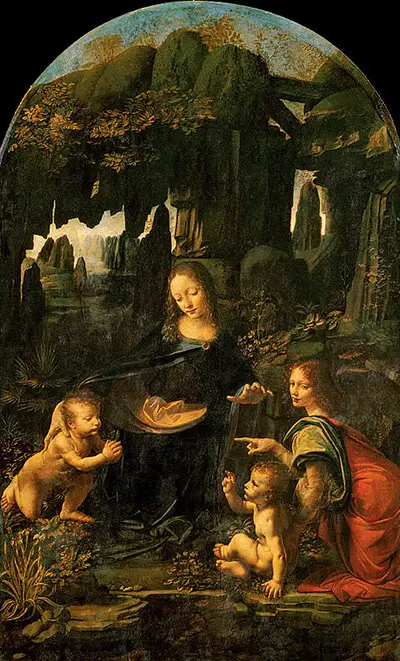Painted by Leonardo between 1483 and 1486 originally on wood, the painting was later transferred to canvas in 1806 by Francois-Toussaint Hacquin, a skilled master restorer.
The painting measures 199cm × 122cm, and hangs in the Louvre. With this painting Leonardo was the first in Italy to experiment with oil paint, although in Northern Europe artists had been using oil for some time.
The Virgin of the Rocks Louvre was the first picture Leonardo painted in Milan, after his move there in 1483.
This fine painting that was to become known as the Virgin of the Rocks was commissioned in 1483 by the Confraternity of the Immaculate Conception in Milan.
The painting was to be the centre of the altarpiece in the Chapel of the Immaculate Conception in the church of San Francesco Grande. The Confraternity contracted Leonardo and the de Predis brothers (a renowned family of Renaissance painters) to provide the principal artwork and surrounding panels.
The project encountered problems: the execution of the work went over the limits, both financial and time. Compromises regarding payments and contractual compliance, and the intervention of King Louis XII, produced a second painting that was finally installed in 1508, while The Virgin of the Rocks Louvre entered the French King's collection.
The Central Figures
Leonardo painted the central composition following a rigid traditional pyramidal scheme, although there is such movement and fluidity in this compact group that any rigidity is imperceptible. All attention falls on the beautiful Madonna. She is soft and maternal; one protective hand is hovering over her baby son at her feet.
Everything about her is soft and subdued yet, in contrast, her dark robe reveals a rich gold lining, a shining shard of colour at the centre of the painting. Her outstretched hand is comfortingly around a praying child. This other child is the infant John the Baptist, kneeling and leaning toward the Christ Child, praying in adoration.
The Christ Child, maybe encouraged by the angel just behind him who is pointing at John, blesses him. According to Florentine tradition, John and Jesus were childhood playmates.
The extraordinarily beautiful angel completes the scene. The angel's face is sublimely stunning; the angel-wings are delicate, diaphanous, almost transparent, while the angel is colourfully robed in bold red and green. It seems Leonardo decided to forego the usual symbolic halos and chose to represent holiness through exquisite beauty.
The Background Rocks
Traditionally, the meeting between the infant John and the Christ Child took place in the desert. Here, Leonardo gives us a curious alternative of rocks and granite.
The tall trees at the back and the true-to-life plants dispersed throughout the landscape, in rich russet colours of Autumn, soften the hard rocks and make the setting a cosy niche embracing the figures.
The softening effect is also rendered by Leonardo's use of the "sfumato" technique. "Sfumato" is, in Leonardo's own words, "blending colours, without the use of lines or borders "in the manner of smoke"". It is a technique he used often. Here, he has created a magical atmosphere: these remarkable rocks, rugged yet quiet, cryptic and intriguing, stretch back into beyond and fade into mist.
The other Virgin of the Rocks
When referring to the Louvre painting, the name of the museum always follows the name of the picture: "The Virgin of the Rocks Louvre". This is because the second version, in London's National Gallery, painted (or supervised) by Leonardo, has the same name. See the alternative Virgin of the Rocks here.
As the original painting did not satisfy the Confraternity's requirements (lack of halos?), the second painting was produced and the first was acquired by the King of France, a great admirer of Leonardo.



